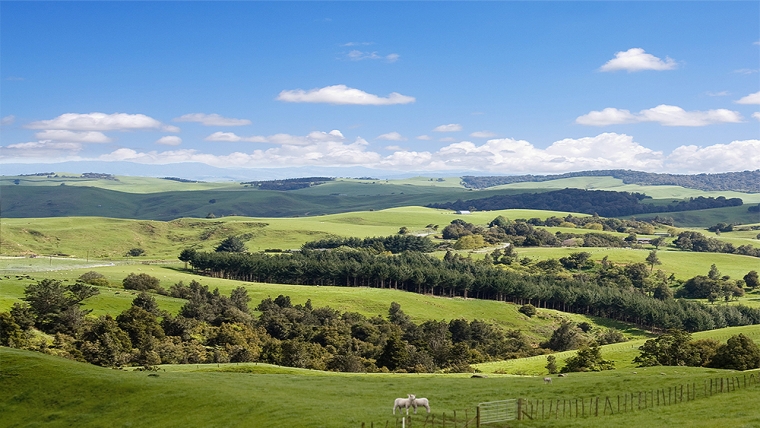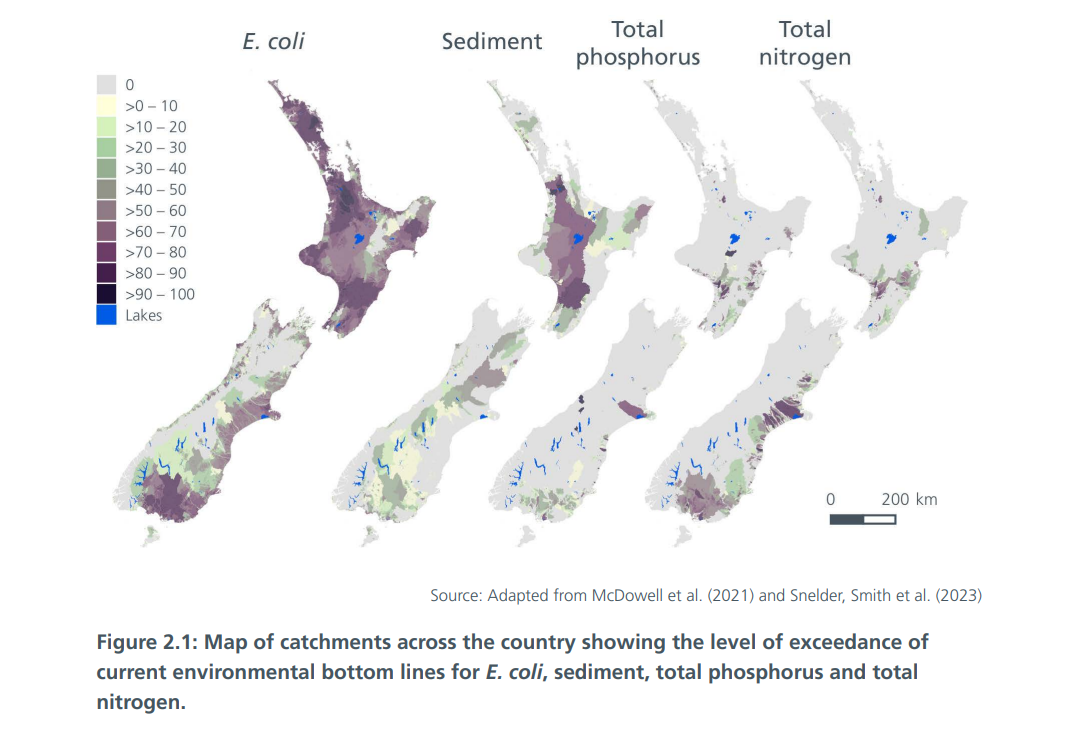
Environmental regulation of farms and forests in New Zealand is often ineffective and works at cross purposes, according to a new report.
The report adds environmental rules for individual farms can fail to improve problems like nitrate levels in water when many different farms share the same catchment area.
The report, Going with the Grain: Changing Land Uses for a Changing Landscape, comes from the Parliamentary Commissioner for the Environment, Simon Upton.
Upton’s report says almost half of all land in New Zealand is used for agriculture and commercial forestry. And this causes environmental problems, such as high levels of four key contaminants: e coli, sediment, phosphorus and nitrogen. And there must be changes in land use to fix this problem in many areas.

But how to do it is the real challenge. The report says government policies have been fragmented, complex and hard to understand. It says farmers have experienced a mass of regulation “landing on the kitchen table at the same time”, which disincentivises the work the regulations are supposed to fix.
“Uncertainty about the scale and timeframes of the required changes and the ways different regulations interact with one another makes it more difficult for landowners to make the large investments required to change land uses,” the report says.
“After all, why would farmers make an investment when it is unclear whether it will help them comply with regulations?”
Upton says many different policies and initiatives have been announced to deal with climate change, freshwater quality and indigenous biodiversity.
“The result has been a mass of overlapping laws, policy instruments and funding programmes. These policies all influence land uses and land management practices. But they are not necessarily pulling in the same direction.”
The report cites current freshwater regulations as an example of ineffective rule making. It says they put obligations on individual farms, meaning the responsibilities for contaminants stop at property boundaries, but the environmental impacts do not.
“While some property boundaries are aligned with physical features of the landscape such as waterways or ridge lines, many are not,” it says.
“As a result…there is often a limit on the impact that individuals can have on improving freshwater quality or biodiversity in their area. Regulating on the basis of property boundaries therefore enshrines a status quo that makes no environmental sense in some places.”
Upton is at pains to avoid prescriptive solutions, in part because the geographical complexity of New Zealand means more research is needed to find the best solutions for each area. He also refers back to a suggestion he made earlier, that carbon offsets from forestry should be made available only to carbon emissions from within the biosphere, and emissions from fossil fuels should have to find their own solutions.
He also cites a parallel study by his office, that looked at land use change in two catchments. One is Northland’s 150-kilometre Wairoa River, which flows into the Kaipara Harbour via Dargaville. The other is Southland’s 240-kilometre Mataura River, which flows through Gore.
It looked at the impact of a change on agricultural emissions, as proposed by the last government, but deferred by the current one. It found even a modest levy would require large areas of the Wairoa catchment to be forested, extending as far as some highly valued dairy land. There would be far less impact on the Mataura catchment, and it cited this difference as another reason why environmental rules should be specifically suited to each region.
Trade-offs required
Upton says difficult trade-offs will be required in some parts of the country between environmental, cultural, economic and social objectives.
"The key message of this report is that central and local government need to be upfront and transparent about these trade-offs and work with communities and mana whenua to agree and manage those trade-offs. Some tough conversations lie ahead, and the process will not be easy. But the quicker we press on with the job, the better," he says.
"Contaminants to water, biogenic greenhouse gases, and biodiversity loss, probably in that order, are the biggest pressures land-based industries currently place on the environment. They also pose risks to continued market access and consumer acceptance as international awareness of the true cost of food production grows," Upton says.
"Even if we want to avoid addressing the environmental pressures that current uses place on the land, an increasingly disrupted climate will leave some landowners stranded."
The modelling we undertook for the Wairoa and Mataura case studies suggested that current policies could encourage the expansion of two dominant monocultures: dairying and pine production forestry. It showed how economically precarious some current land uses are, suggesting that the status quo is neither environmentally nor economically viable beyond the short term."
'A one-size-fits-all approach to regulation does not work'
Upton’s report was welcomed by the lobby group Beef + Lamb New Zealand (B+LNZ).
It says the report shows that a one-size-fits-all approach to regulation does not work.
B+LNZ Chairwoman Kate Acland says the case studies show that existing and expected environment-related policies and rules, if left unchanged, could lead to a significant decline in the sheep and beef sector.
“B+LNZ has been calling for pragmatic and enduring solutions that balance environmental progress with sustainable food production,” she says.
“Our sector acknowledges further progress needs to be made. But the Parliamentary Commissioner for the Environment report supports the need for a fundamental revision of how that improvement occurs – meaning a more integrated approach to environmental management.”
Acland says B+LNZ supports the recommendation of a catchment-based approach to environmental rules, along with increased, and enduring, investment in environmental data at the regional level, so landowners can have confidence that management changes are working.
“B+LNZ will continue to advocate for more targeted approaches to environmental policy, and for the removal of impractical and ineffective rules,” Acland says.
25 Comments
One wonders if the recent about face by Fonterra regarding having consumer brands is partially driven by an acceptance that we will never meet environmental standards that are acceptable to the modern consumer. And that a B2B model allows the problems to be hidden from the consumer behind a layer of obfuscation by the FMCG company.
And will never benefit from meeting those standards, double edged sword. Yes, the clean green nz had to be pulled back because of the dirty truth, and there's a long way to go to achieve nationwide, and then market. But catchment sized achievements and marketing, maybe.
Blimey. We might have to start talking WITH one another & actually coming up with local solutions that work for those living there. I have posited before that our future long term governance needs to be more locally driven [no, not the current local governance model] & now we have a conversation starter, & a pretty important one I would argue. I'd like to hear Keith's take on this before ranting too much, but in general, I'd like to see the regions run as businesses, but with a heart, & send less money to Wellington full-stop.
I think we could run WEllington on about half the current budget, with the balance returning in the regions were their prosperity was created.
I disagree about the local solutions premise. Thats how the RMA is managed and we know its been a mess almost since it was enacted with nimbys and other objectors
An example from KB today
"In Porirua we have a problem (it seems) with cross connection of stormwater into the sewage system. Every time it rains heavily, the sewage system can’t cope with volumes, and it overflows into Titahi Bay, which is horrible.
What they’re trying to do to remediate that is to install a 7 million litre tank into which a bunch of the sewage flows and is pumped away to the treatment plant. Normally it is pretty empty, but in heavy rain it can fill up and regulate the volume going to the plant. All well and good.
Until they discovered that there were northern grass skinks living in the area of works.
So what they did was spend 2 months collecting as many as they could, and rehoming them. They relocated 60 skinks.
Bit of an eye roll but, hey…
Until you discover that this 2 month exercise caused a six month delay to the project, increasing the cost by $10,000,000.
Ten. Million. Dollars. For 60 skinks. $166,666 per skink.
The worst bit? They’re not even endangered."
I worked on that sewage scheme back in the 90s. The sewage is pumped up over the hills , has minimal treatment, then piped out to ten sea. So they are protecting the whole Harbour. Not just a few skink.
A project that started in May, then finally in October they got around to doing the site evaluation.
My cynical thought is that some slack project management is trying to sheet the blame home to these skinks.
Seems logical to base local management on the rivers catchment area, as it was with the catchment boards before the regional councils came in.
I would say you could break it down even further, with upper catchment getting priority. Some of the lower river reaches are pretty much basket cases, not all from farming either.
There's too many fingers in the decision-making pie. Or put another way, too many cooks in the kitchen.
So just you and a few folk like you, eh?
Everyone else has to stay out?
Strike you as just a tad self-centred?
The protest against mining held in blackball attracted a dozen half-baked, deranged individuals. Most were from elsewhere not blackball
So Mr Chicken Little, who are you talking about as "a few folk like you"? When it comes to "self centred", you are confessing to your own flaws
I guess whoever is profiting from the environmental destruction is planning to sell for the purpose of destroying the planets climate?
You should relax a bit. Glaciers have covered the Earth and completely gone again raising sea levels by up to 90m: all without the tiniest ICE engine or coal mine ever being built. So don't worry about the "planet's climate" life has thrived at CO2 levels twice of that found today and there used to be far more carbon in our biosphere - you can tell that because of the vast quantities which have been sequestered from a gargantuan bulk of living organic carbon over millions of years.
Excellent work from Simon.
as another comment here says, we really do need to move away from the one sized Wellington model for a number of things. Obviously there is not much in common between Southland and Northland.
imagine having a shared objective set nationally, with implementation done locally? Imagine how fast the best areas would take up the challenge! We would make many local heroes, build stronger communities, give meaningful opportunities to local people.
I despair. Great to see Simon Upton talking about payment for ecosystem services, but then he gets into this mode of someone has to pay and the costs will be enormous. Take this paragraph in his conclusion;
Socialising the costs of land use change is always the easiest route politically, but it can be eyewateringly expensive. If it required $80 million of public money to reduce the flow of nutrients into Lake Taupō, the sum required to purchase changes in land use intensity across the country on a similar basis would be huge. That is why the first port of call must always be finding profitable alternative uses. But it will not always be possible: from our case study work, the cost of restoring one pocket of the Hikurangi repo (wetland) in Northland could be as much as $120 million depending on how you went about it. But just to buy back the land would require nearly $20 million.
"Eyewateringly expensive"?????
So, $80m to reduce nutrient flow into Lake Taupo (as above) - but check this out;
https://infrastructurepipeline.org/project/te-ara-tupua - $500m for an active transport project between the Hutt and Wellington
And $120m to restore a part of the Hikurangi swamp/wetland in Northland (a critically important sediment filter for the spawning grounds of the Kaipara Harbour) - well let's compare that amount of money to the $880m Pūhoi to Warkworth 'holiday highway'.
And his last example of $20m to buy back the land needed to get that sediment trap (wetland restoration) underway - heck just today the government announced $43m to the private sector to deliver Gumboot Friday over the next 4 years.
Simon Upton is selling the environment short - so terribly short. When is his term up?
The active transport project includes protection works for the road and railway.
I'm not sure how your blaming Upton for the costs or the fact it's very unlikely to be funded
He can only advise.
I'm blaming the PCE for thinking these costs to improve our environmental health are "enormous". And hence the reason I provided other examples about what our politicians choose to spend taxpayer money on - which are much, much more "enormous".
It's all a matter of priorities and of all people, the PCE is supposed to advocate to the government to prioritise the environment.
That paragraph seemed to be an apology for the magnitude of the costs needed to restore our ecosystems to a healthy state.
Look again at the first graphic of e coli levels across in our waterways across the North Island. It is truly shameful.
I think he means to take that 80 million and extrapolate to nationwide would be enormous. And above lake taupo is relatively clean. The lower Waikato, 80 would be pissing in the wind.
I did my apprenticeship in a freezing works and would sometimes work on the sewage system. I saw the chemist taking samples at the outlet one day. And I asked him what he was doing. He sighed and said, we just monitor it.
More on the state of Kaipara Harbour - the snapper spawning grounds;
https://www.nzherald.co.nz/northern-advocate/news/fish-with-milky-blood…
So how much do we think that wetland restoration is worth now? What's the value of the TAC in a single year for snapper on the West Coast of the North Island. Might want to count that as part of the cost of "do nothing".
And of course, no snapper means kina barrens, but the idiotic Minister thinks we can "eat" our way out of the problem;
https://www.beehive.govt.nz/release/community-hui-talk-about-kina-barre…
https://legasea.co.nz/2024/05/02/legasea-newsletter-146-we-cant-eat-our…
… It showed how economically precarious some current land uses are, suggesting that the status quo is neither environmentally nor economically viable beyond the short term."
therein lies the problem with all this. Fine to talk about doing things differently but the cruel economic reality is many areas will radically change, regulation or no regulation, as they continue to go broke. Those communities and land uses will disappear as they have through all civilizations through history.
It all seems a bit hopeless, to be this far into the current environmental crises and we are still talking about organisational changes that would take at least 15 years to implement.
Perhaps the economic optimum (from a DCF commercial point of view), is simply to minimise expenses on governance and so on, and "party on" for whatever time remains until the now inevitable catastrophe.
For a bit of a laugh;
Need a side hustle in these tough times? Here are your National-approved options
Carr to retire, others to step down.
That's the Climate Change Commission - this report is from the Office of the Parliamentary Commissioner for the Environment. Unrelated entity. PCEs are on a five-year term, which can be extended once only. I'm pretty sure Upton is in his second term at this stage.

We welcome your comments below. If you are not already registered, please register to comment
Remember we welcome robust, respectful and insightful debate. We don't welcome abusive or defamatory comments and will de-register those repeatedly making such comments. Our current comment policy is here.